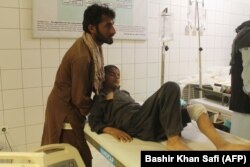Dozens of angry villagers screamed in anguish and beat their own faces outside a hospital in the northern Afghan province of Kunduz on April 3, a day after dozens of people were killed and wounded when the Afghan military unleashed an aerial assault on what it said was a gathering of Taliban leaders.
But eyewitnesses and villagers who survived the attack claim the air strikes in the Taliban-controlled Dasht-i Archi district in Kunduz Province did not target militants, and killed dozens of civilians -- including children -- who had gathered for a religious ceremony.
Residents of Dasht-i Archi claim no members of the Taliban were present as hundreds of people gathered for dastaar bandi, a ceremony marking the graduation of young men who have memorized the Koran, Islam's holy book.
“I swear to God, I will kill myself if the government is not held accountable,” screamed one man who sunk to his knees in front of the Zone Hospital in the provincial capital, Kunduz.
“I lost my nephew,” yelled another man.
“The government are infidels,” shrieked another man as he raised his hands toward the sky.
Blame Game
Defense Ministry spokesman Mohammad Radmanish rejected claims that the strikes targeted civilians, telling a news conference in Kabul on April 3 that aerial footage and images showed Taliban members gathered in a compound with vehicles and motorbikes, carrying Taliban and Pakistani flags. He alluded that if any civilians were killed, they were killed by the Taliban.
But other government officials admitted that a number of civilians had been killed in the strikes.
"The Afghan National Army, based on precise information, tried to destroy it to save the people from great disaster, but there are reports that, unfortunately, civilian casualties were also caused in the attack," President Ashraf Ghani's office said in an April 3 statement. Ghani said an investigation into the deadly air strikes had been launched.
Nasruddin Saadi, the district governor of Dasht-i Archi, said on April 3 that the air strikes hit a mosque and religious school, killing and wounding around 150 people.
The United Nations Assistance Mission in Afghanistan (UNAMA) said the same day that its investigators were in the area looking into "disturbing reports of serious harm" to civilians.
Swaths of Kunduz Province, located along the border with Tajikistan, are controlled by the Taliban. The militants have twice seized control of the provincial capital in recent years. The province has been the scene of a number of deadly air assaults, including in 2015 when U.S. air strikes destroyed a hospital, killing 42 people, most of them patients and medical staff.
'Everything Was Destroyed'
Amanullah, a resident of Dasht-i Archi, located around 80 kilometers from the provincial capital, told RFE/RL's Radio Free Afghanistan on April 3 that the air strikes hit a ceremony for which hundreds had gathered in the Gojar Akhundzada mosque and nearby fields. He claimed around 50 civilians were killed and scores injured.
"The helicopters first fired artillery and then rockets,” said Amanullah as he stood outside Zone Hospital. “Everything was destroyed. The area was littered with dead bodies and body parts.”
“There was nobody there to help us,” added Amanullah, who only goes by one name. “There were no ambulances. We had to transport the wounded by car to Kunduz city.”
Amanullah claimed there were no Taliban fighters present at the religious ceremony in the district.
“There were only civilians,” he says. “Most were clerics and religious students. It was a graduation ceremony for students."
Another man at the hospital, who did not want to be identified, claimed 50 civilians were killed.
“The attack lasted a long time,” he said. “There were no vehicles to transfer the wounded. We had to drive the wounded here ourselves."
A middle-aged man standing in a dark corridor of the hospital said the air strikes had caused a “devastating scene.”
“We found my cousin in the rubble and brought him here to the hospital,” he says, wiping his face with his scarf. “It was his graduation day."










